What Are DeFi Liquidations?
DeFi liquidations occur when the deposited collateral’s value falls below a certain threshold of the debt value. When this happens, the borrower’s position will be considered undercollateralized and the collateral will be liquidated.
Key Takeaways
-
Lending platforms let borrowers use their cryptocurrency assets as collateral to borrow other assets from the protocol, and DeFi loans are usually overcollateralized.
-
When the deposited collateral’s value falls below a certain level and the loan is not repaid, the deposited collateral will be liquidated.
- Borrowers and lenders can use tools like Block Analitica to analyze risk management in DeFi.
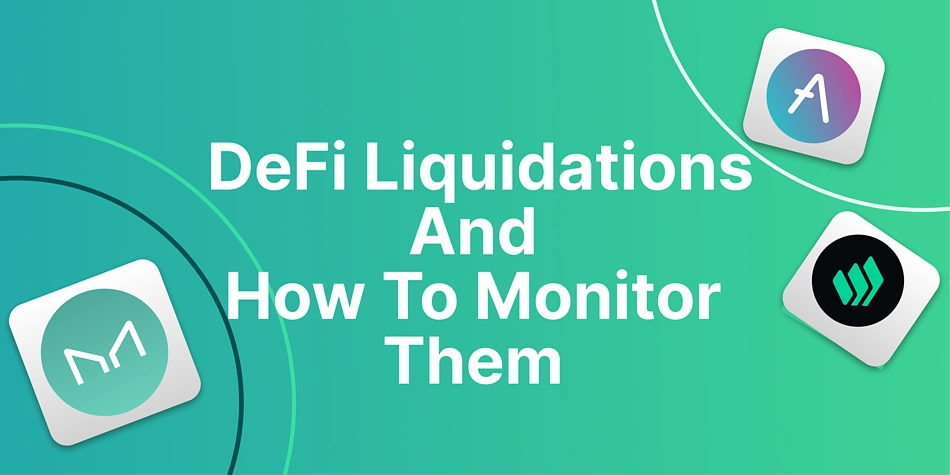
Decentralized finance was once a 'safe haven' for users who wanted to earn interest on their cryptocurrency assets, as opposed to the meager returns that traditional finance had to offer. However, these relatively new ways of putting your money to work aren't always safe, and interest accrued over time can be lost in the blink of an eye. In this article, we'll explore how liquidation events work in DeFi, and learn more about how to avoid them and monitor them live.
DeFi Lending in a Nutshell
To fully grasp how liquidations function, it's first essential to revisit and comprehend the fundamentals of using lending protocols such as the well-known Aave, MakerDAO, and Compound which allow users to borrow and lend funds.

Most Popular Lending Platforms
These lending platforms enable borrowers to use their own cryptocurrency assets as collateral to borrow other assets provided by the chosen protocol. The borrower's collateral, which can range from extremely volatile to relatively stable cryptocurrencies, is deposited on the platform and locked in smart contracts, as a security measure in the event that the loan cannot be repaid.
Overcollateralization
To borrow cryptocurrency, the individual wishing to borrow (the borrower) must deposit a crypto asset of their choice that is worth more than the amount they wish to borrow. This is known as overcollateralization.
In other words, users must deposit more collateral than the amount they want to borrow. This ensures that if circumstances take a turn for the worse, the excess value will provide a substantial buffer to protect lenders against borrower defaults.
How DeFi Liquidations Happen
DeFi liquidations occur when the value of the collateralized assets drops beyond a certain threshold. When the value of the collateralized assets starts falling, the borrower may run into difficulties and could become unable to provide enough collateral to continue keeping their decentralized loan open, and once this happens, the deposited collateral will be liquidated.
“If the value of the deposited collateral falls below a certain level and the loan is not repaid, the corresponding account will be liquidated.”
How a liquidation works will depend on how DeFi protocols use smart contracts. The liquidation event is done by the liquidation engine that runs on the code of smart contracts. This ensures not only the solvency of the protocol but also that the lender's funds are at all times protected and the borrower's outstanding debt is repaid in full.
For example, the smart contract might sell the collateral for the borrowed asset at current market prices. This sale would then be used to repay the lender, and if luck is on the side of the borrower, any remaining funds would be returned to the borrower who was liquidated.
Decentralized Liquidations in History
When we look at the several biggest liquidations that happened through the course of decentralized finance history, we see the largest price drop, which was 48.11% on a single day, (March 12, 2020).
The day that later became known as Black Thursday, which essentially permanently REKT many DeFi users, never to return again. This black swan event, in reaction to the COVID-19 news (seen below) led to sizable forced liquidations across centralized exchanges as well as DeFi lending markets.

Black Thursday - 2020.03.12
Other Liquidation Events
But as we already know, crypto has more black swan events than any other industry and looking back, ‘Black Thursday’ wasn't the only fat-tail event that could be observed and which had a significant impact on the portfolio, positions and mood of DeFi users.
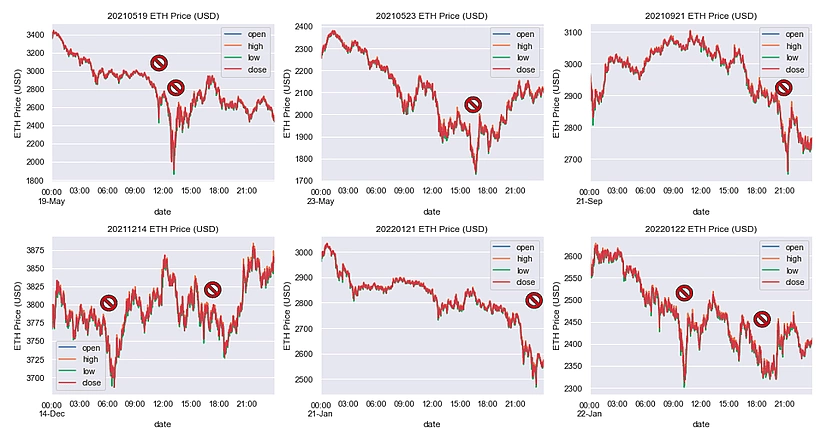
Other Liquidation Events - Black Swans
The charts above illustrate the historical price behavior and market corrections in relation to several significant events: the May 2021 flash crash driven by China FUD and environmental concerns; SEC FUD in September 2021; reaction to the emergence of the Omicron variant in December 2021; the Wall Street crash and declines in the Nasdaq index in January 2022; and further price drops on January 22nd associated with rising interest rates and tighter monetary policy by the Federal Reserve which contributed to a more risk-off sentiment.
These frequent portfolio destroying events force us to understand why you should always remain cautious using DeFi, serving as a cautionary tale of the risk of decentralized finance.
The Importance of Monitoring DeFi Liquidations
Now that we know how liquidations occur and that liquidations in DeFi can happen more often than one should like, we can shift our understanding to focus on position and risk management to avoid liquidations.
This is especially important if you are a borrower who must maintain sufficient collateral value to prevent unwanted liquidation events. But also on the flip side, it can be crucial for a lender who can monitor their borrowers' collateral values to ensure they themselves leave nothing to luck, and try to act prudently whenever necessary.
Even if you are not involved in decentralized lending and have so to speak, no 'skin in the game', you can always choose to observe from the sidelines and gain insights on how others manage their risk and positions. This is a perfect way to get more familiar with DeFi and understanding the DeFi market.
How to Monitor DeFi Liquidations With Block Analitica
Block Analitica is a risk management firm that leverages the open transaction transparency of Ethereum and computational techniques like simulation modeling and machine learning to gather actionable intelligence, which is perfectly suited to analyze risk and position management in decentralized finance.
Let's explore these tools, all made by Block Analitica, and use them to get a behind-the-scenes look at how lending and borrowing work in DeFi protocols.
MakerDAO Analytics: Liquidations Dashboard
The first tool is a monitoring service fully focused on the lending platform MakerDao. On the MakerDAO Analytics tool we find the following information: active liquidation in the dashboard, past liquidations and some interesting metrics.
The Maker auction system introduced in May 2021 has successfully liquidated 2,255 positions, which refers to the total number of times the protocol has had to seize collateral due to borrowers failing to maintain their necessary collateral.
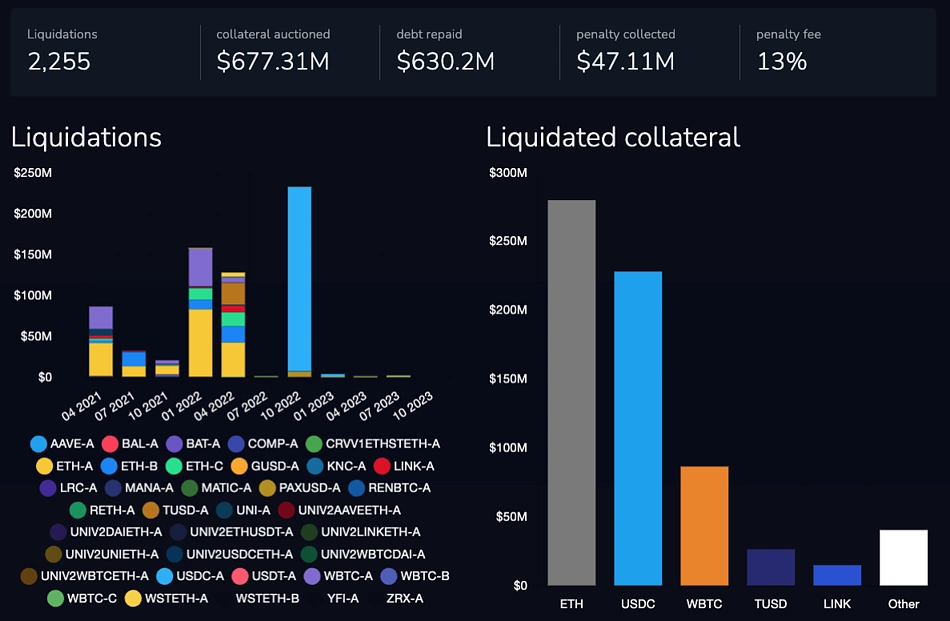
Display of MakerDAO Analytics Dashboard
The total value of collateral that has been liquidated or taken over by the protocol as a result of these 2,255 liquidations is $677.31 million.
$630.2 million in debt repaid indicates the total amount of debt that has been repaid by borrowers using the platform.
$47.11 million collected in liquidation penalties relates to when a loan becomes undercollateralized. The protocol seizes the borrower's assets and sells them off, often through other users who are incentivized by earning a portion of the penalties.
Out of all the liquidated collateral, we see that ETH and USDC lead the pack in sold-off collateral.

Live Dashboard of most recent liquidations on MakerDAO
Aave Analytics: Liquidations Dashboard
The second tool is a monitoring service fully focused on the lending platform Aave. On this tool we also find the same information as for the MakerDAO dashboard, such as: a liquidation dashboard, past liquidations, and some metrics.
If we take a look at Aave, we see that the protocol has resulted in $890.11 million in collateral being seized, $840.29 million in debt that has been repaid, and $49.82 million being collected in liquidation bonuses, which are the incentives for users or smart contracts to liquidate undercollateralized loans.

Display of Aave Analytics Dashboard
Wrapped ETH (wETH) is the main liquidated collateral, with wBTC as the second most liquidated. We can see wETH and wBTC being auctioned off in liquidation events as borrowers lost their collateral crypto assets.
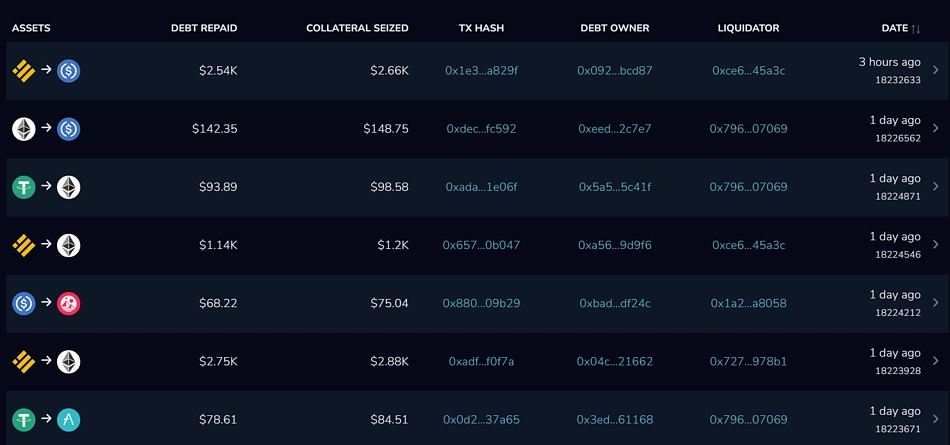
Live Dashboard of most recent liquidations on Aave
Compound Analytics: Liquidations Dashboard
The third one is for the lending market Compound. With the Compound Analytics tool, we can take a look at the dashboard and find ourselves in the midst of DeFi liquidations happening on the lending platform Compound.
The Compound protocol has seen 180 liquidations, during which $68.71 million worth of collateral was seized. Borrowers repaid $65.19 million in debt, while the protocol collected $3.52 million in liquidation penalties. The liquidation engine is running on lower numbers than the other two protocols, but is working as intended.
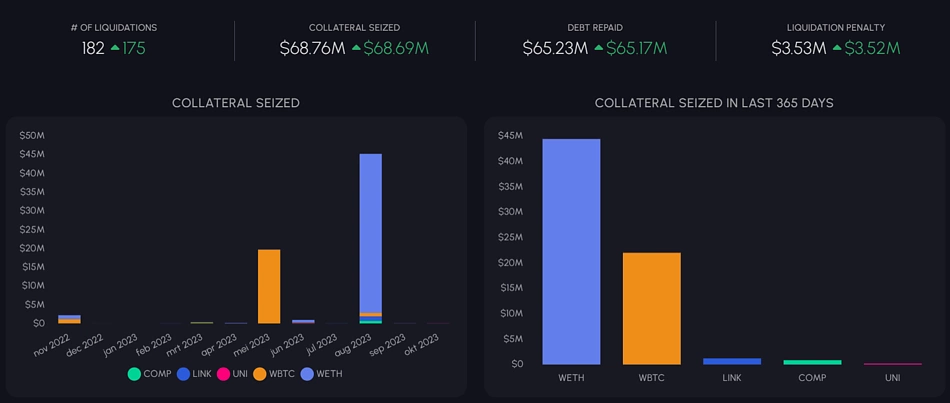
Display of Compound Analytics Dashboard
Although we can’t see numbers of the all time liquidation events on Compound, we can see a history of the last year and Wrapped ETH (wETH) again is number one liquidated collateral.

Live Dashboard of most recent liquidations on Compound
Individual Wallet Monitoring
Project Levon is a more applicable tool that focuses on individual wallets and their risk profiles. Also made by Block Analitica, Levon provides an efficient and easy way to use decentralized credit scoring.
From now on we don’t look at the decentralized lending markets, but take a closer look at the individual users that make up decentralized finance. With this tool we can see, just like in traditional lending, the historical information, borrowing capacity, and backup capital of the borrower.
Although this individual wallet assessment tool is currently only available on MakerDAO, it can give us a glimpse of the DeFi credit risk framework for lenders and borrowers by providing an unbiased view depending solely on public on-chain data.
Whale Wallet Case Study
Now with this tool, we can analyze a whale wallet engaged in DeFi – 0x741a...31f3. This wallet has almost $400 million in debt and is deeply involved in decentralized finance. We can run the numbers on it and take a closer look.
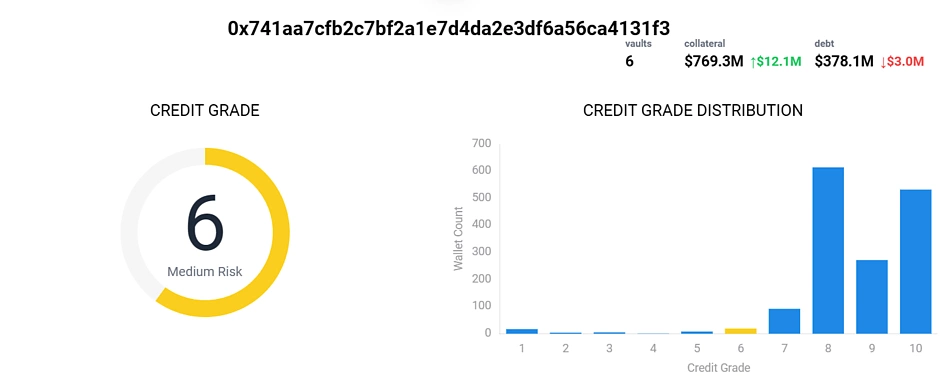
Levon's grade ranges from 1 (very high risk) to 10 (very low risk). It also positions the selected wallet in a 'credit grade distribution' that assigns its risk level compared to other wallets.
In our example, the whale wallet is assigned a medium risk (credit grade 6) which is lower than the majority of wallets using Maker vaults.
Levon determines this score by combining several factors that contribute to the whale wallet's risk profile. Let's take a look at what factors.

Collateralization Buffer
The whale wallet has a low collateralization buffer of 1.17. This means the ratio of its collateralization over the liquidation ratio is safe for now. The lower this number gets, the more risk there is of liquidation. An account gets liquidated at 1, so the higher the buffer number, the more room there is before reaching liquidation.
Credit Mix
Next we see that the wallet has a low credit mix score, which represents the riskiness of the collateral in the position. This score is derived from the different vaults and underlying assets associated with the address.
External Capital
On the other hand, externally held capital refers to the amount of available capital the wallet has outside of MakerDAO. A borrower could have considerable amounts of capital distributed in other protocols, like Aave and Compound. If things go south, they can always sell these tokens to repay debt depending on their liquidity in the open market.
Protection Service
This analysis takes into consideration that the wallet uses an automation program like DeFi Saver, which automatically manages and tracks DeFi positions. Using such a program provides better risk management because it works to avoid liquidations.
Baseline Score
The Baseline Score is the cornerstone of the grading system. It looks at how the wallet has acted in the past to try to predict if it will do a good job protecting itself in the future. Several factors are taken into consideration for this assessment;
- How often the wallet interacts with its accounts to manage risks
- If it interacts at different times of the day
- How recently it has interacted
- How much money it has borrowed total
- How many interactions it has had recently
- If it pays back what it borrows
- How long it has been using Aave

Baseline Score Factors
Individual Wallet in MakerDAO Analytics
Going back to the MakerDAO dashboard discussed above, we can click through to our whale wallet and see their risk of liquidation in DeFi.
The market would have to drop significantly before this wallet's Maker vault assets are in the danger zone. We see that at minimum, ETH would need to drop 16% in value before there is cause for concern. However, knowing crypto markets, drops of this magnitude can happen rapidly. Let's hope this whale knows how to navigate the turbulent deep waters of DeFi.
Wallet Tracking MakerDAO Analytics
Conclusion
While decentralized liquidations happen automatically through smart contract code, which has no emotions and simply executes programmed logic, they may seem harsh when prices suddenly crash before bouncing back. However, liquidation engines play a crucial role in maintaining the viability of the DeFi ecosystem by ensuring lenders are repaid and borrowers are held accountable.
And despite the many black swan events crypto has seen, even in DeFi's early days, we can say the decentralized system is working as intended. This shows that finance is headed in the right direction, even with volatility. More people globally will likely be attracted to decentralized lending as DeFi matures.
By understanding liquidation risks and using grading tools for analysis, DeFi users can make better informed decisions and learn where finance is headed. Knowledge of liquidations empowers us to navigate turbulent markets.

Hans entered the space in 2017 for the quick gains but ended up staying poor. Since 2020, he has contributed to many crypto projects and has written several blog posts in English and Dutch. By sharing his research and findings, he hopes that everyone reading can make better informed decisions.









 Or check it out in the app stores
Or check it out in the app stores